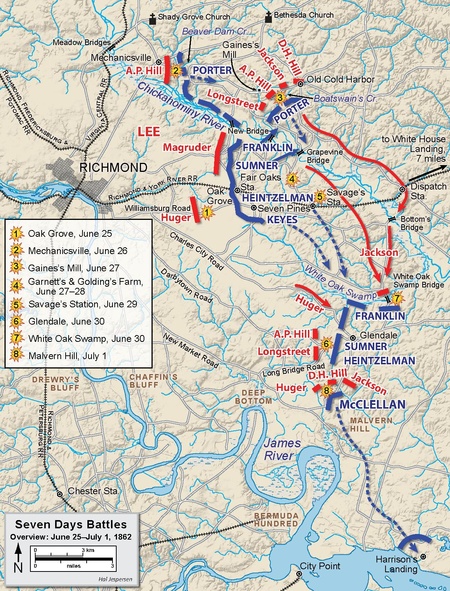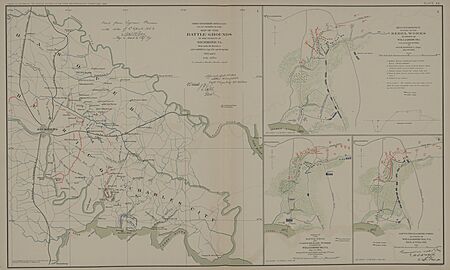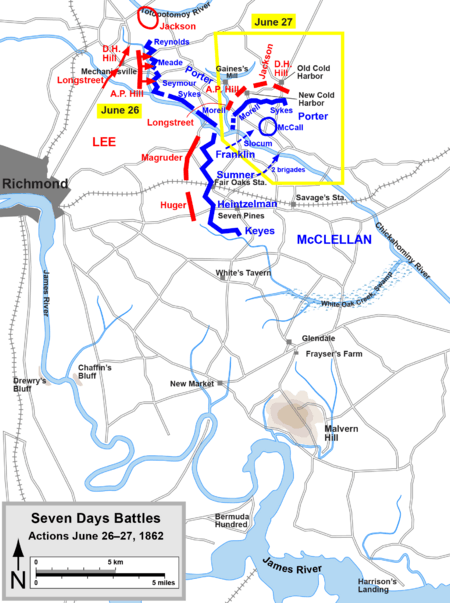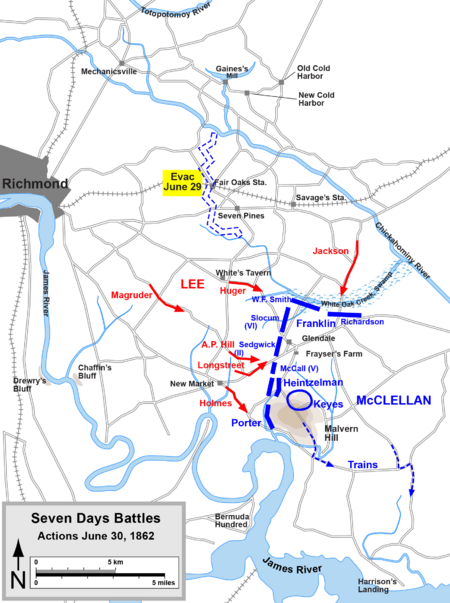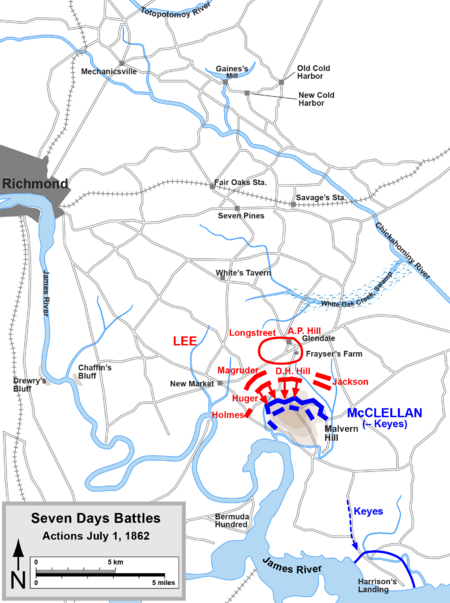Seven Days Battles facts for kids
Quick facts for kids Seven Days Battles |
|||||||
|---|---|---|---|---|---|---|---|
| Part of the American Civil War | |||||||
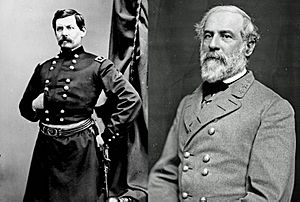 George B. McClellan and Robert E. Lee, respective commanders of the Union and Confederate armies in the Seven Days |
|||||||
|
|||||||
| Belligerents | |||||||
| Commanders and leaders | |||||||
| Units involved | |||||||
| Strength | |||||||
|
101,434 ("present for duty"):
|
112,200 "present for duty" | ||||||
| Casualties and losses | |||||||
| 15,855 1,734 killed 8,066 wounded 6,055 missing/captured |
20,204 3,494 killed 15,758 wounded 952 missing/captured |
||||||
The Seven Days Battles were a series of seven big fights that happened over seven days, from June 25 to July 1, 1862. These battles took place near Richmond, Virginia, during the American Civil War. Confederate General Robert E. Lee led his army to push back the Union Army, commanded by Maj. Gen. George B. McClellan. The Union Army was trying to capture Richmond, the capital of the Confederacy.
The Seven Days Battles began on June 25, 1862, with a Union attack called the Battle of Oak Grove. However, General McClellan quickly lost control of the situation. General Lee then launched a series of attacks. These included battles at Beaver Dam Creek (June 26), Gaines's Mill (June 27), and Savage's Station (June 29).
McClellan's army had to retreat towards a safe spot called Harrison's Landing on the James River. Lee tried to stop the Union Army one last time at the Battle of Glendale on June 30. But his plans didn't work out perfectly. This allowed the Union Army to escape to a strong defensive spot on Malvern Hill. At the Battle of Malvern Hill on July 1, Lee's army attacked many times but lost a lot of soldiers.
The Seven Days Battles ended with McClellan's army safe by the James River. The Union Army lost about 16,000 soldiers. Lee's army, which was attacking, lost over 20,000 soldiers. After these battles, Lee decided that McClellan wouldn't attack Richmond again. So, he moved his army north for new campaigns.
Contents
- Why Did the Battles Happen?
- The Armies Involved
- The Battles Begin
- Oak Grove: McClellan's Only Attack
- Beaver Dam Creek: Lee's Plan Goes Wrong
- Gaines's Mill: A Confederate Victory
- Union Retreat: A Change of Plans
- Garnett's & Golding's Farm: Small Skirmishes
- Savage's Station: Burning Supplies and Confusion
- Glendale and White Oak Swamp: Missed Chances
- Malvern Hill: A Costly Attack
- What Happened Next?
- Images for kids
- See also
Why Did the Battles Happen?
The Peninsula Campaign: A Failed Plan
The Peninsula Campaign was a Union plan led by General McClellan to capture Richmond, the Confederate capital. The goal was to end the war quickly. It started in March 1862 when McClellan landed his army near Fort Monroe. He then moved northwest up the Virginia Peninsula.
However, Confederate defenses surprised McClellan. He had hoped for a quick advance but instead had to prepare for a long siege of Yorktown. Before the siege was ready, the Confederates, now led by General Johnston, started to retreat towards Richmond.
There were several smaller battles during this campaign. The Union Army won some of these, like parts of the Battle of Williamsburg (May 5). But the Confederates kept retreating. An attempt by the United States Navy to reach Richmond by river was also stopped at the Battle of Drewry's Bluff (May 15).
As McClellan's army got close to Richmond, a battle happened at Battle of Seven Pines (May 31 and June 1). This battle was a tie and had many casualties. But it was important because General Johnston was wounded. He was replaced by the more aggressive General Robert E. Lee on June 1.
Lee spent almost a month making his defenses stronger and organizing his Army of Northern Virginia. McClellan waited patiently for better weather and roads. Lee, who was known for being careful earlier in the war, knew his army was smaller than McClellan's. But he planned a bold attack, showing how aggressive he would be for the rest of the war.
Lee's Attack Plan
Lee's plan was complicated. He knew he couldn't win by just waiting or by a long siege. He wanted to attack McClellan's army quickly. His plan was decided at a meeting on June 23.
The Union Army was split by the Chickahominy River. Most of it was south of the river. But one part, the V Corps under General Fitz John Porter, was north of the river. Lee planned to cross the Chickahominy with most of his army to attack Porter's forces. He would leave only two divisions to defend Richmond against McClellan's larger force. This meant about 65,500 Confederate soldiers would attack 30,000 Union soldiers.
Confederate cavalry, led by General J.E.B. Stuart, had explored the area. They found that Porter's right side was weak. Lee wanted General Stonewall Jackson to attack Porter's right side early on June 26. Then, General A.P. Hill would move in and attack the Union lines. Lee hoped Porter would have to leave his defenses. After that, Generals Longstreet and D.H. Hill would join the battle. Other Confederate generals would make small attacks to distract McClellan. Lee hoped to surround Porter's forces and cut off McClellan's supplies.
McClellan's Counter Plan
McClellan also planned an attack. He knew Lee was getting ready to move. He also knew that General "Stonewall" Jackson's troops were coming from the Shenandoah Valley. McClellan decided to attack before Lee could. He wanted to move his big siege cannons closer to Richmond. To do this, he planned an attack on Oak Grove. This would help his soldiers attack a key area from two sides.
The Armies Involved
Almost 200,000 soldiers fought in the Seven Days Battles. This made them some of the biggest battles of the war. However, the generals often didn't use all their soldiers together. This meant they couldn't win a complete victory.
The Confederate army was not as organized as the Union Army. It was a collection of troops gathered to defend Richmond. This made it harder for General Lee to coordinate his attacks and destroy the Union Army.
Union Army
| Union Corps Commanders |
|---|
|
McClellan's Army of the Potomac had about 105,000 soldiers. It was organized into several corps:
- II Corps, led by Brig. Gen. Edwin V. Sumner.
- III Corps, led by Brig. Gen. Samuel P. Heintzelman.
- IV Corps, led by Brig. Gen. Erasmus D. Keyes.
- V Corps, led by Brig. Gen. Fitz John Porter.
- VI Corps, led by Brig. Gen. William B. Franklin.
- There were also cavalry and supply forces.
Confederate Army
| Confederate Commanders |
|---|
|
Lee's Army of Northern Virginia was larger than before, with about 92,000 soldiers. This was the largest Confederate army gathered during the war. Key commanders included:
- Maj. Gen. Stonewall Jackson, who had just won battles in the Shenandoah Valley.
- Maj. Gen. A.P. Hill, whose "Light Division" was known for moving fast.
- Maj. Gen. James Longstreet, who also oversaw Hill's division.
- Maj. Gen. John B. Magruder.
- Maj. Gen. Benjamin Huger.
- Maj. Gen. Theophilus H. Holmes.
The Battles Begin
Oak Grove: McClellan's Only Attack
On June 25, McClellan planned to attack west towards Richmond. His target was a dense forest near the White Oak Swamp. Two Union divisions, led by Brig. Gens. Joseph Hooker and Philip Kearny, were chosen for the attack. They faced Confederate Maj. Gen. Benjamin Huger's division.
The Union attack started around 8 a.m. Some Union brigades made good progress. But others struggled through thick woods and swamps. Confederate forces, led by Brig. Gen. Ambrose R. Wright, counterattacked. One Confederate regiment, the 26th North Carolina, fired a perfect volley, causing a Union regiment to panic and retreat.
McClellan, who was three miles away, ordered his men to pull back. But when he arrived and saw the situation wasn't so bad, he ordered them to retake the ground. Fighting continued until nightfall.
This was McClellan's only attack against Richmond during the Seven Days. He gained only about 600 yards. Both sides lost over 1,000 soldiers. This small attack wasn't enough to stop Lee's bigger plans.
Beaver Dam Creek: Lee's Plan Goes Wrong
Lee's plan for June 26 was for Jackson to attack Porter's right side. Then, A.P. Hill would join in. But Lee's detailed plan immediately went wrong. Jackson's soldiers were tired and arrived at least four hours late.
By 3 p.m., A.P. Hill got impatient and attacked without orders. He sent 11,000 men in a direct assault. Porter's Union soldiers were well-defended with 14,000 men and 32 cannons. They easily stopped the Confederate attacks, causing many casualties.
Jackson finally arrived late in the afternoon. But he ordered his troops to rest, even though a major battle was happening nearby. McClellan, worried about his supply lines, ordered Porter to retreat further east. McClellan also believed he was greatly outnumbered, though he wasn't. This decision was very important. It meant he would have to give up his siege of Richmond.
The battle was a Union victory in terms of tactics. The Confederates lost many soldiers (1,484 vs. Porter's 361) and didn't achieve their goals. Only about 15,000 Confederates fought, instead of the planned 60,000. Despite the Union's win, it was the start of a big problem for them. McClellan began to retreat and never got the upper hand again.
Gaines's Mill: A Confederate Victory
By the morning of June 27, Union forces were in a semicircle. Porter's troops were north of the river, and four corps were south. McClellan told Porter to hold Gaines's Mill at all costs. This was so the army could move its supply base to the James River. McClellan's officers wanted him to attack Magruder's division south of the river. But McClellan refused, fearing the large number of Confederates he thought were there.
Lee continued his attack on June 27. He launched the largest Confederate attack of the war, with about 57,000 men. A.P. Hill attacked again but found the Union line lightly defended. By early afternoon, he met strong resistance where Porter was set up. The swampy land made it hard to attack.
Again, Jackson was late. D.H. Hill attacked the Union right but was held back. Longstreet was ordered to make a fake attack to hold the lines until Jackson arrived. In Longstreet's attack, Brig. Gen. George E. Pickett's brigade was pushed back with heavy losses. Jackson finally arrived at 3 p.m. and started his attack at 4:30 p.m.
Union lines were saved when Brig. Gen. Henry W. Slocum's division arrived. Shortly after dark, the Confederates attacked again. This time, they broke the Union line. Brig. Gen. John Bell Hood's Texas Brigade created a gap. By 4 a.m. on June 28, Porter's troops crossed the Chickahominy River, burning bridges behind them.
Magruder continued to trick McClellan south of the river. He kept 60,000 Union troops busy with small attacks. This allowed the main battle to happen north of the river.
Gaines's Mill was the only clear Confederate victory of the Peninsula Campaign. The Union lost 6,837 soldiers out of 34,214. The Confederates lost 7,993 out of 57,018. Even though the Union V Corps suffered heavily, the rest of the Union Army was still in good shape. However, this defeat made McClellan nervous. He decided to give up his advance on Richmond.
Union Retreat: A Change of Plans
On the night of June 27, McClellan ordered his entire army to retreat to Harrison's Landing on the James River. This decision has puzzled historians ever since. The Union army was in a good position. It had stopped strong Confederate attacks using only one of its five corps. McClellan also knew that new Union troops were being sent to reinforce him. But Lee had made him lose his nerve, and he gave up the attack.
McClellan sent a message to the Secretary of War. He complained that he owed no thanks to Washington for saving his army. He then left for Harrison's Landing without giving clear orders for the retreat or naming a second-in-command. For the rest of the Seven Days, he was not directly leading the battles. The Union retreat was a big psychological win for the Confederacy. It showed that Richmond was safe.
Lee's cavalry reported that Union troops had left their defenses and supply depots. This, along with seeing large dust clouds, finally convinced Lee that McClellan was heading for the James River. Until then, Lee thought McClellan would retreat east.
Garnett's & Golding's Farm: Small Skirmishes
While the big battle at Gaines's Mill was happening, Confederates south of the Chickahominy River were trying to find McClellan's retreating army. Magruder ordered Brig. Gen. Robert A. Toombs to "feel out the enemy." Toombs, a politician, instead launched a strong attack at dusk on June 27. The Union forces easily pushed back his attack.
On June 28, Toombs attacked again in the same area. He ordered another brigade to join him. Two of their regiments attacked first and were met with a strong Union counterattack. They lost 156 men.
These were small attacks, but they helped convince McClellan that he was being attacked from everywhere. This made him even more determined to get his army to safety on the James River.
Savage's Station: Burning Supplies and Confusion
On June 29, most of McClellan's army gathered at Savage's Station. This was a Union supply depot. They were getting ready to cross the White Oak Swamp. There was no central leader because McClellan had left for Malvern Hill without giving clear orders. Union soldiers were told to burn anything they couldn't carry. Morale dropped, especially for wounded soldiers who realized they would be left behind.
Lee planned to chase and destroy McClellan's army. His plan was complex. Longstreet and A.P. Hill's divisions would go to Glendale. Holmes's division would go to Malvern Hill. Magruder's division would attack the Union rear guard. Stonewall Jackson was supposed to rebuild a bridge and attack Savage's Station, joining Magruder.
But Lee's plan went wrong again. Jackson was slow, rebuilding bridges and getting confused orders. On the Union side, General Heintzelman decided his corps wasn't needed and left without telling anyone.
Magruder faced the problem of attacking 26,600 Union soldiers with only 14,000 of his own. He waited until 5 p.m. and sent only two and a half brigades forward. Union cannons fired, and the fight became a bloody stalemate as darkness and thunderstorms arrived. An armored railroad battery, the "Land Merrimack," fired shells at the Union front.
About 1,500 soldiers were lost on both sides. Plus, 2,500 wounded Union soldiers were left behind and captured. Jackson finally crossed the river at 2:30 a.m. on June 30, but it was too late. Lee had hoped to crush the Union Army.
Glendale and White Oak Swamp: Missed Chances
By noon on June 30, most of the Union Army had crossed White Oak Swamp Creek. About a third of the army reached the James River. But the rest were still marching between the swamp and Glendale. McClellan himself rode south and boarded a ship on the James River.
Lee ordered his army to attack the retreating Union forces. The Union Army was spread out and disorganized. Stonewall Jackson was supposed to attack the Union rear guard at White Oak Swamp. The largest part of Lee's army, about 45,000 men, would attack the Union Army at Glendale. This would split the Union Army in two.
Again, the Confederate plan was poorly carried out. Huger's men were slowed by fallen trees. He spent hours cutting a new road and didn't join the battle. Magruder wandered around, unsure where to go. Stonewall Jackson moved slowly and spent the whole day north of the creek. He made weak attempts to cross and fought a pointless cannon duel. Jackson's slowness allowed Union troops to reinforce Glendale. Holmes's inexperienced troops also failed to make progress against Union forces at Malvern Hill.
At 2 p.m., Lee, Longstreet, and Confederate President Jefferson Davis were meeting when they came under heavy cannon fire. Longstreet ordered an attack to silence the Union cannons. This started a general fight around 4 p.m.
The main attacks came from A.P. Hill and Longstreet's divisions. They were the only ones to follow Lee's order to attack the main Union force. Longstreet's 20,000 men attacked 40,000 Union soldiers. The heaviest fighting was around the position held by the Pennsylvania Reserves, about 6,000 men.
Confederate brigades attacked one by one over several hours. They fought fiercely, sometimes hand-to-hand. Union divisions on the flanks held strong against repeated attacks. Heavy fighting continued until about 8:30 p.m.
The battle was a tie, but Lee failed to stop the Union escape. Union casualties were 3,797, and Confederate casualties were similar at 3,673. However, the Confederates had more killed and wounded. Jackson's part of the army did little fighting, mostly just a cannon duel.
Malvern Hill: A Costly Attack
The last battle of the Seven Days was the first where the Union Army had a strong defensive position. Malvern Hill offered good views and places for cannons. Union General Porter's V Corps had prepared it the day before. McClellan was not there, having gone ahead to Harrison's Landing.
The hillsides were cleared of trees, giving clear views. The open fields could be swept by deadly fire from 250 cannons. Almost the entire Union Army was on the hill.
Instead of going around the position, Lee attacked it directly. He hoped his cannons would clear the way for his soldiers. His plan was to attack from the north.
Once again, Lee's complex plan didn't work well. His soldiers were delayed by muddy roads and bad maps. Jackson stopped at a swampy creek. Magruder's guides sent him the wrong way.
Union artillery, led by Col. Henry J. Hunt, fired first. From 1 p.m. to 2:30 p.m., they launched one of the biggest cannon attacks of the war. The Union cannons were better and destroyed most of the Confederate cannons. Despite this, Lee sent his soldiers forward at 3:30 p.m. By 4 p.m., Magruder arrived and was ordered to support the attack. His attack was disorganized. Confederate troops only got within 200 yards of the Union center and were pushed back by nightfall with heavy losses.
Lee's army lost 5,355 soldiers (compared to 3,214 Union losses) in this wasted effort. But they kept following the Union army to Harrison's Landing. The Confederates had a chance to control the Union camps from a nearby hill, Evelington Heights. But Union forces captured the heights before Confederate soldiers could get there.
What Happened Next?
Our success has not been as great or complete as we should have desired. ... Under ordinary circumstances the Federal Army should have been destroyed.
My conscience is clear at least to this extent—viz.: that I have honestly done the best I could; I shall leave it to others to decide whether that was the best that could have been done—& if they find any who can do better am perfectly willing to step aside & give way.
The Seven Days Battles ended the Peninsula Campaign. Malvern Hill was not a good place to stay, so the Union Army quickly moved to Harrison's Landing. There, Union gunboats on the James River protected them. The army was too tired for another attack. Nearly 16,000 Union soldiers were killed, wounded, or captured. The survivors were exhausted, low on ammunition, and many were getting sick.
Meanwhile, the Confederate Army, also tired, went back to Richmond.
McClellan wrote to the War Department, claiming he faced over 200,000 Confederates. He asked for many more soldiers to attack Richmond again. But General-in-Chief Henry Halleck said this was impossible. He also pointed out that staying in the swampy Virginia Peninsula during mosquito season would cause many diseases like malaria. On August 4, McClellan was ordered to leave the Peninsula and return north.
Both sides lost many soldiers. Lee's Army of Northern Virginia lost about 20,000 soldiers out of 90,000. McClellan's army lost about 16,000 out of 105,445. Even though they won, many Confederates were shocked by how many men they lost. The number of casualties in the Seven Days Battles was more than all the casualties in the Western part of the war up to that point.
The Seven Days Battles had big effects. The North's spirits were crushed by McClellan's retreat. Even with heavy losses, the South's morale soared. Lee felt confident to continue his aggressive strategy. He went on to fight the Second Battle of Bull Run and the Maryland Campaign. McClellan lost his position as general-in-chief of all Union armies. Lee also removed some generals, like John Magruder and Benjamin Huger, who had not performed well.
Images for kids
See also
 In Spanish: Batallas de los Siete Días para niños
In Spanish: Batallas de los Siete Días para niños
- Armies in the American Civil War
- List of costliest American Civil War land battles
- Troop engagements of the American Civil War, 1862














